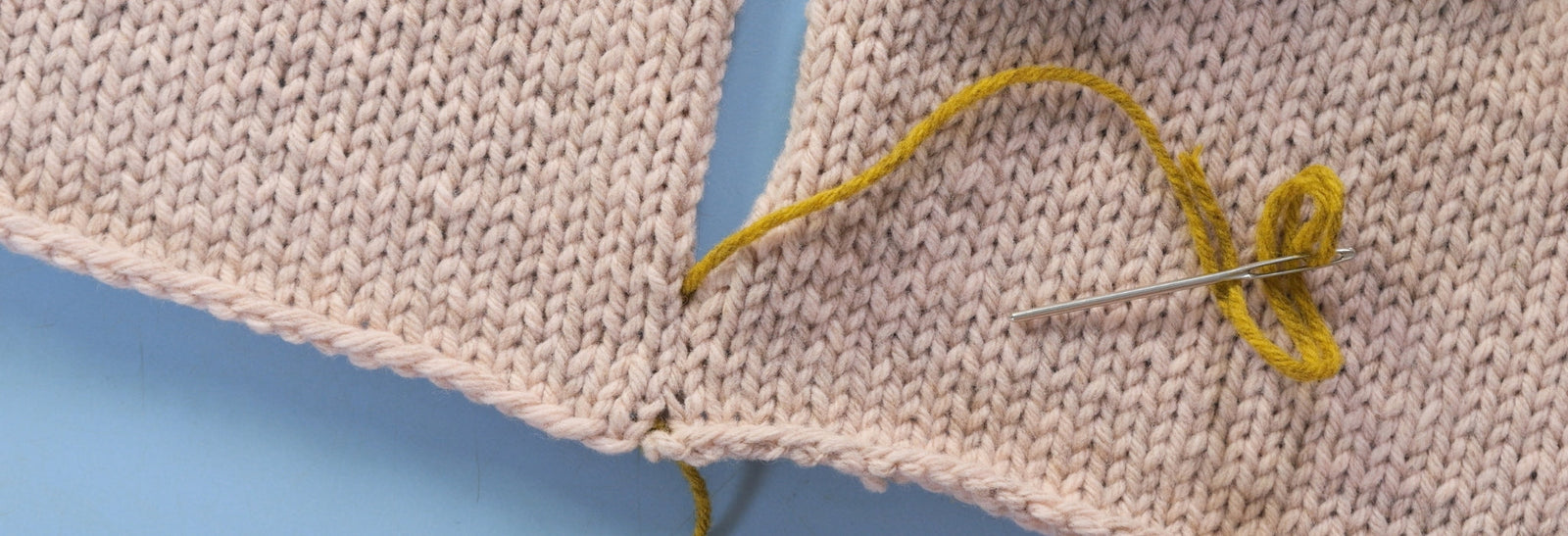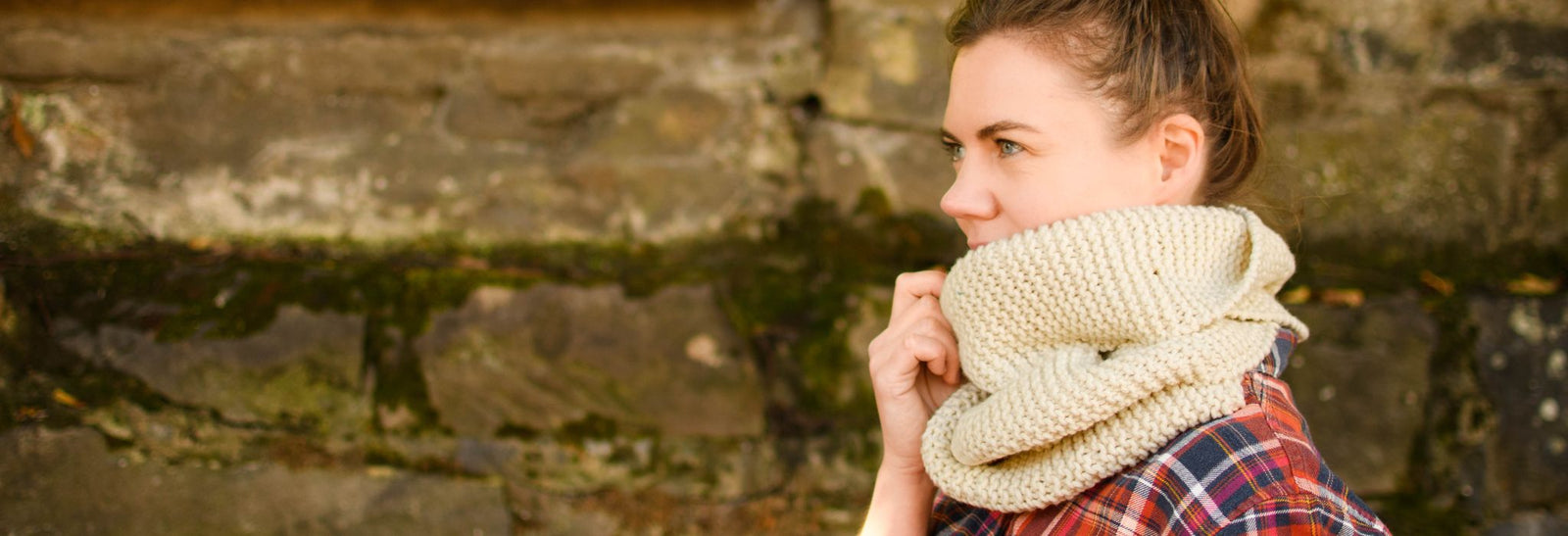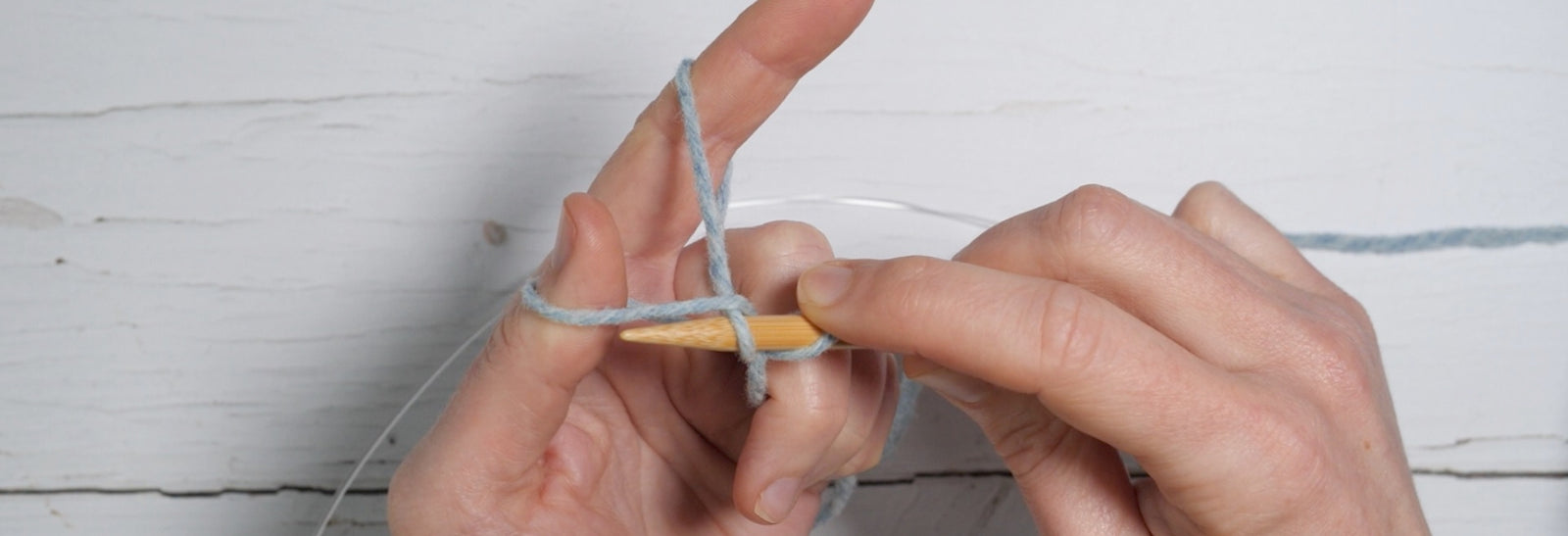Your Cart is Empty

Alternating cable cast on tutorial
November 01, 2019
An alternating cable cast on is a useful, stretchy cast on for ribbing that’s less fussy to work than a tubular cast on. It’s worked like a regular cable cast on, but instead of casting on each stitch knitwise stitches are alternately cast on knitwise and purlwise.
This tutorial includes both step by step photos and videos so you can use whichever suits you better.

Begin with a slipknot, leaving a short tail.

Place the slipknot on the left needle tip. The cast on will be worked with the ball end of the yarn.

Insert the left needle into the slipknot from front to back, as if to knit,

and wrap the yarn around.

Draw the loop through the stitch.

Bring the left needle tip towards you and insert it into the new stitch from right to left.

Slide the new stitch off the right needle

and onto the left.

Cast on the next stitch purlwise. Insert the right needle between the stitches, from back to front, as if to purl, and wrap the yarn around.

Draw the loop through the stitch

and slip it to the left needle,

with the same twist as before.
Continue casting on knitwise, then purlwise, always inserting the needle between the first 2 stitches on the left needle. Slip each cast on stitch to the left needle by bringing the left needle towards you and inserting it from right to left into the stitch.

For an even number of stitches end with a knit stitch. If you’re working in the round you’ll probably want to begin your ribbing with a knit stitch so I recommend working the first row of ribbing before joining in the round.
Here's a video if you prefer to see how the stitches are moved:
Alternating cable cast on for 2x2 rib
To work an alternating cable cast on for 2x2 rib you need to work the cast on for 1x1 rib and then rearrange the stitches on the first row. This will be familiar if you’ve ever worked a tubular cast on for 2x2 rib.

The cast on is set up knit one, purl one.

The first stitch is a knit stitch. Knit this stitch.

The second stitch on the left needle is now a knit stitch.

Insert the right needle tip into this stitch at the front, from right to left.

Slip the first two stitches off the left needle. At the back, scoop up the free stitch

and then slip the knit stitch back to the left needle.

Knit the next stitch. Purl two, then knit the next stitch.

Repeat the process to rearrange the next two stitches.Continue in this way to the end of the row.
Alternating cable is a really useful cast on to have in your repertoire. It's almost as good a match for ribbing as a tubular cast on, and I think it's more or less as elastic. The alternating cable cast on is particularly useful for socks, hats and sweaters.

Give it a try and if you have any questions please ask in the comments.
Also in Journal

Learn to Knit: Mattress Stitch
March 29, 2023
By following our step-by-step mattress stitch knitting tutorial, you'll learn how to make your seams look beautiful and how best to prepare your knitting so that when you seam it with mattress stitch, it goes smoothly on the first try.
Read More
How to Knit a Scarf: A Beginners Guide to Scarf Knitting
March 23, 2023
Want a quick and easy beginners tutorial on how to knit a scarf? This garter stitch scarf is easy to knit and requires just 3 skills; casting on, the knit stitch and casting off.
Read More
Learn to knit: the long tail cast-on
February 03, 2022
The long tail cast on is a great multi-purpose knitting cast on and the perfect place for beginner knitters to start. Learn how to work the long tail cast on and how to estimate the length of yarn needed with our clear step by step tutorial and video.
Read More Recent Articles
- Learn to Knit: Mattress Stitch March 29, 2023
- How to Knit a Scarf: A Beginners Guide to Scarf Knitting March 23, 2023
- Learn to knit: the long tail cast-on February 03, 2022
- How to Kitchener Stitch December 09, 2021
- Crochet Provisional Cast-on December 02, 2021
- Learn to knit: How to knit in the round with double pointed needles November 25, 2021
- Learn to knit: How to knit in the round using the magic loop technique November 25, 2021
- Learn to knit: How to knit in the round November 25, 2021
- Knitted Gift Ideas for you and your loved ones November 18, 2021
- Celebrating our Porty Hat Preview Knitters October 28, 2021
Free resources
-
KALS, step-by-step pattern guides and free patterns
Learn brioche with the free Daniel's Hat pattern
Tombreck - a free chevron beanie pattern
Working the brioche neck detail on the Polwarth sweater
Basics
Casting on
Decorative Channel Island Cast-on
Binding off
3 Easy Stretchy Bind-offs (p2tog bind-off; k2togtbl, k1 bind-off; Jeny's surprisingly stretchy bind-off)
Tubular Bind-off for brioche stitch
Increasing
Paired increase methods compared
Decreasing
Brioche stitch double decreases
Knitting in the round
How to Knit in the round using Magic Loop
How to Knit in the round using DPNs
Short rows
Swatching and gauge
Tips and tricks
Avoiding ears when binding off
Tighter purl stitches for neater cables and ribbing
Cabling without a cable needle
Reading knitting patterns
Understanding "continue in pattern"
Finishing
Garment knitting
Joining the body and sleeves on a seamless bottom up sweater
Sizing
Inclusive garment knitting
How to pick a garment without a model for you (specifically addresses finding garment patterns when your gender identity isn't represented and the styles you want to knit might not be sized to fit your body)
How does ease affect inclusive size ranges?
Specific stitch patterns
Lace
Identifying and fixing mistakes in lace knitting
Colourwork
Getting started with stranded colourwork
Understanding colour dominance
Working stranded colourwork over small circumferences
Decreases in stranded colourwork
Holding the yarn for stranded colourwork
Ladderback Jacquard (a neat way to deal with long floats)
Cables
Cabling without a cable needle
Cabling without a cable needle on the wrong side
How to knit cabled decreases
Closed ring cable increases and decreasesBrioche
How to work brioche stitch in the round
Other crafts
Cross stitch
How to begin your first large cross stitch project
How to finish a cross stitch project with an embroidery hoop frame
Mending

Sign up today
Find out the latest news from the studio such as sales, pattern releases, and new workshops or KALs our learning community, The Knitwork. We also share helpful tips and exclusive subscriber discounts...

